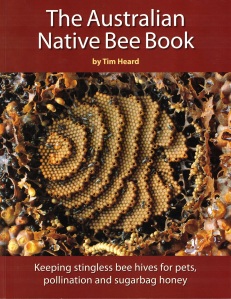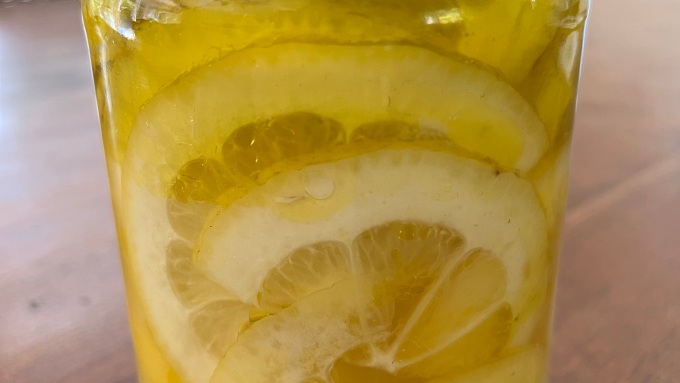This is a delicious, quick and simple recipe for when you have a glut of lemons … You will need: 3 medium lemons – preferably home grown, organic or chemical free3 tablespoons of salt3 tablespoons… More
Davidson’s Plum …
COVID-19 Update: For the past couple of months, we have all been busy Isolation Baking, trying out new recipes or re-visiting old ones. As I was lucky enough to be offered several kilograms of Davidson’s Plums, I decided to revisit the recipe I posted in 2012, update it a bit and repost. So here it is …
The summer after I moved to my new house I was excited to discover a mature Davidson’s Plum tree at the back of the property. I was excited for two reasons. Firstly it seems that neither bats nor birds are attracted to the fruit, and secondly and very conveniently the fruit drops when ripe and all you have to do is pick it up. I placed some weed mat under the tree to stop the fallen fruit rolling away into the undergrowth, but I missed some and now have several small trees growing around the base.
Davidson’s Plum fruit and jam are becoming more readily available, and can be found in some gourmet and “bush tucker”stores if you don’t want to wait the 4-5 years for your tree to fruit. I have a Davidsonia jerseyana – which is native to the sub-tropical rain forests of Northern New South Wales. The fruit of this tree is extremely tart and only the very brave would attempt to eat it raw. If you can eat a lemon, you could probably cope with a Davidson’s Plum! It also has 100 times the Vitamin C found in oranges.
It’s very low in pectin so if you want to make a nice thick jam you’ll need to add some. Rather than add the commercial stuff, I experimented with green apples. My recipe Davidson’s Plum Jam works quite well and the resulting jam has a tangy/sweet taste which goes particularly well with toasted macadamia and fruit bread from Bellingen’s Hearthfire Bakery
Davidson’s Plum Jam Recipe …
Davidson’s Plum Jam Recipe
See my post on Davidson’s Plums
500 gm Davidson’s Plums
500 gm sugar
One large green apple
juice of half a lemon
½ a vanilla pod – split open
Packet of pectin on standby (eg: Jamsetta)
- Wash the plums in a sieve to remove any dust or dirt. Cut the plums in half and make sure that you remove the two small seeds. Then chop the plums into quarters. Wear gloves if you don’t want to end up with nasty purple fingernails.
- Peel and core the apple and chop it finely, or grate it.
- Put the plums, apple, lemon juice and sugar into a saucepan and add just enough water to stop the bottom layer from burning (approximately 20mls) – no more or it will take too long to reduce.
- Bring the water to a simmer slowly, stirring all the time to ensure that the sugar is dissolved before the liquid starts boiling.
- Add the vanilla pod.
- Put a small saucer in the freezer to chill
- Leave on a gentle simmer for 1-2 hours until the mixture has thickened and reduced. Test the jam by dropping a teaspoonful on the frozen saucer – it should almost immediately thicken.
- Sometimes, if the plums are not very ripe or particularly watery, the jam will not set, rather than use more sugar I will add some pectin. Follow the instructions on the packet.
- I only recently learnt that if you freeze fruit, it reduces the gelling effect of the natural pectin. So if you do this, you will almost certainly need Jamsetta or similar.
- Allow to cool slightly. If you want a smooth jam, you can blitz with a stick blender. Then spoon into sterilized jars.
I’m an exhibitionist !
I’m very lucky to live in Bellingen. Amongst its many attractive aspects, is the enthusiastic nurturing of artistic endeavour. Nobody looks down on your amateurish attempts to produce something that might qualify as “art”. Even the real artists offer words of encouragement.
Years ago a work colleague commented that she thought I didn’t have a left-brain, and whilst I accept that I am very focused on process and organisation, I thought that was somewhat harsh!
Over the years I’ve tried a few things – painting, sketching, pottery, etc and not discovered anything that grabbed me until I attended an Eco Dyeing course at Camp Creative a few years ago. I still remember the puzzled looks I got when I told friends that I was doing the course. “No, I’m not going to crochet my own hemp shroud – that’s dyeing not dieing”.

Anyway, I was hooked from the first day, and I’ve been experimenting and hoarding eco-printed paper ever since. The hoarding was becoming a problem until the lovely Cynthia offered me space in her private gallery, and a joint opening with Leonie another budding artist. The opening was a huge success – wine, delicious food, great conversation and best of all … SALES!
I was quite hesitant about exhibiting, but I discovered that framing makes all the difference to an eco-print. Turning it from a scrap of paper to something that you might just want to hang on your wall …
So thanks to Cynthia, Leonie and all the friends and acquaintances who attended the opening, and a special thanks to those who bought our artwork.
I’ll be eco-printing more paper soon, but I’m trying to be patient. I made the decision to use only plants from my garden, and preferably Australian natives, but I fell in love with Cotinus (Smoke Bush) leaf prints, so I’ve been forced to plant one. I’m trying to leave it alone and not strip off all the leaves like I did last autumn
Bzzzzzzzzzzzzzzzzzz …
It’s winter, and it’s around now that I start to stress a little …
The nights are cold, we’ve had long periods of rain, and the daytime temperature often doesn’t reach 18 degrees. And 18°C is the magic number when it comes to my native bees (Tetragonula carbonaria). Below 18°C they stay in the hive and won’t come out to forage, which means they use their stores of nectar and pollen to stay alive.

Native bees don’t hibernate so the inside temperature of the hive is also really important. Extended periods of cold can kill a hive. I have a mental picture of them all huddled together trying to keep warm, sipping honey and telling tall (or small?) stories to while away the hours.
With all this in mind, I was understandably nervous about splitting my hive, but finally last spring, with the help of a friendly local native bee enthusiast, I felt brave enough to take the risk. So very early one Sunday morning, we cracked it open and were rewarded with the sight of a healthy, honey and pollen filled hive.
We put a new top on the base of the old hive and vice versa and sealed the joins with tape to keep out predators until the bees could seal it themselves. The new hive is now sitting under the Pecan tree where it will get some winter sun.

Still feeling a bit cowardly, I decided to take the minimum amount of honey, and give the bees the best chance to rebuild the hive and to set aside stores for winter.
Native bee honey is quite runny, and it has a strong complex flavour. Drizzled over vanilla bean ice-cream, I can tell you that it was absolutely delicious!
The good news is, that so far after each spell of cold rainy weather, as soon as the daytime temperature reaches 18°C – out they come . Fingers crossed for the rest of winter.
 PS: If you are looking to keep native bees in Australia,
PS: If you are looking to keep native bees in Australia,
this is the bible , by entomologist Dr. Tim Heard.
Or even better, if you live in NSW or QLD you might be able to get to one of his fascinating seminars or workshops.
This is how I got hooked!


























